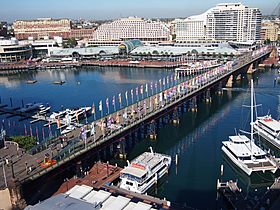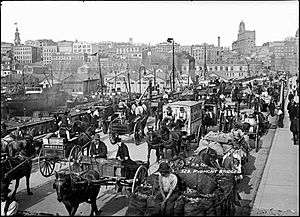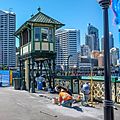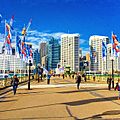Pyrmont Bridge facts for kids
Quick facts for kids Pyrmont Bridge |
|
|---|---|

Pyrmont Bridge in 2014.
|
|
| Coordinates | 33°52′14″S 151°12′02″E / 33.870575°S 151.200667°E |
| Carries | Pedestrian and bicycle traffic |
| Crosses | Cockle Bay |
| Locale | Darling Harbour, Sydney, New South Wales, Australia |
| Owner | Sydney Harbour Foreshore Authority |
| Maintained by | Sydney Harbour Foreshore Authority |
| Heritage status |
|
| Preceded by | Pyrmont Bridge (1858–1902) |
| Followed by | Western Distributor (1981–present) |
| Characteristics | |
| Design | Swing bridge |
| Material | Ironbark timber; Steel central spans |
| Total length | 369 metres (1,211 ft) |
| Number of spans | 14 |
| Clearance above | 6.5 metres (21 ft) |
| History | |
| Engineering design by | Percy Allan |
| Construction begin | 6 December 1899 |
| Construction cost | £112,569 |
| Opened | 28 June 1902 |
| Statistics | |
| Daily traffic | ~14,000 pedestrians |
| Official name | Pyrmont Bridge |
| Type | State heritage (built) |
| Designated | 28 June 2002 |
| Reference no. | 1618 |
| Type | Road Bridge |
| Category | Transport - Land |
The Pyrmont Bridge is a special kind of bridge called a swing bridge. It crosses Cockle Bay in Darling Harbour, which is part of Sydney, Australia. This bridge is very old and important, so it's listed as a heritage site.
It first opened in 1902. Back then, cars and trucks used to drive across it, connecting the main part of Sydney to the area called Pyrmont. But since 1981, only people walking or riding bikes can use the bridge. Cars now use nearby freeways. The bridge was added to the New South Wales State Heritage Register on June 28, 2002, exactly 100 years after it first opened.
Contents
History of Pyrmont Bridge
The very first Pyrmont Bridge opened on March 17, 1858. It was made of wood and had an iron part that could swing open. This allowed ships to pass through. In its first two weeks, 20,000 people paid a small fee (one penny) to cross it.
The government bought this first bridge in 1884 for £52,500. After that, they stopped charging people to cross.
Building the New Bridge
The wooden Pyrmont Bridge was replaced by a new steel bridge in 1902. This new bridge took 33 months to build. It was ready just in time for Sydney's first cars.
Engineers started planning a new bridge in 1891. However, an economic downturn delayed the project. In 1894, after looking at many ideas, they chose a design for a steel bridge. This design had a swing part that was 54 feet (16.5 meters) long. It allowed two clear paths, each 70 feet (21 meters) wide, for boats.
The foundation stone for the new bridge was laid on September 6, 1899. A foundation stone is like a special first brick. The bridge officially opened on June 28, 1902. It was opened by Harry Rawson, who was the Governor of New South Wales.
How the Swing Bridge Worked
The new Pyrmont Bridge was powered by electricity. This was very modern for its time. The swing part of the bridge could open and close in just 45 seconds.
Percy Allan, a chief engineer, designed the Pyrmont Bridge. He also designed over 550 other bridges.
Changes Over Time
In 1980, a part of the bridge was changed to make way for a new freeway called the Western Distributor. A year later, in 1981, the Pyrmont Bridge was permanently closed to cars. All vehicle traffic was moved to the new freeway.
The government first wanted to tear down the bridge. But they changed their minds. In 1984, the Darling Harbour Authority was created. Their job was to redevelop the Darling Harbour area. The Pyrmont Bridge was repaired and its swing part was made to work again. It became a bridge just for people walking.
An elevated walkway was built so people could easily get from the bridge to Market Street. A monorail track was also built across the bridge at this time. The Pyrmont Bridge reopened for walkers in 1988.
After the monorail stopped running in July 2013, its tracks were removed from the bridge. Some changes made for the monorail were reversed. For example, the bridge's braking system was changed back to hand-operated. The control room was also moved back to its original spot in the middle of the bridge.
The government plans to spend money to update the Pyrmont Bridge. This will help keep it in good condition for the future.
What the Pyrmont Bridge Looks Like
The Pyrmont Bridge was designed by Percy Allan. When it was built, its swing part was one of the biggest in the world. It was also one of the first swing bridges to use electricity to open and close. Allan also designed a similar bridge called the Glebe Island Swing Bridge.
The Pyrmont Bridge is 369 meters (1,211 feet) long. It cost £112,500 to build. The bridge has 14 sections, called spans. Twelve of these spans are made from strong Australian ironbark timber. The two middle spans, which are the ones that swing open, are made of steel.
The swinging part of the bridge weighs 1,000 short tons (907 metric tons). It sits on a base made of concrete and Hawkesbury Sandstone. This base weighs 6,800 short tons (6,169 metric tons). The swinging part is 13 meters (43 feet) wide and 19 meters (62 feet) deep. The water under the bridge is 6.5 meters (21 feet) deep. The base goes another 10 meters (33 feet) below the sea floor.
How the Bridge Opens
The Pyrmont Bridge takes about 60 seconds to open completely. It opens to an 83-degree angle. It needs to open for boats that are taller than 7 meters (23 feet). Once open, boats up to 21.5 meters (71 feet) wide can pass through.
The bridge is powered by its original two 50-horsepower electric motors. These motors use 600-volt DC electricity. The power for the bridge used to come from the Ultimo Power House, which is now the Powerhouse Museum.
Bridge Changes and Recognition
In 1981, the government decided to close the bridge to cars. It was then reopened as a pedestrian bridge. This was part of a big project to redevelop Darling Harbour. The swing bridge still works today and opens on a schedule for boats.
In 1992, a group called Engineers Australia recognized the Pyrmont Bridge as a National Engineering Landmark. This means it's a very important example of engineering in Australia.
How the Bridge Was Modified
When it was first built, the bridge had stone parts at both ends. These connected it to nearby streets. In 1980, most of the eastern stone part was removed to build the Western Distributor freeway.
Between 1988 and 2013, the bridge carried the elevated Sydney Monorail. The monorail track was designed to stay still while the bridge swung open. This meant the monorail could still cross even when the bridge was open. Building the monorail led to some changes. For example, the bridge's hand-operated brakes were made electric. The control room was also moved.
After the monorail closed in 2013, its tracks were removed. The control room was moved back to its original spot in the middle of the bridge.
Why Pyrmont Bridge is a Heritage Site
The Pyrmont Bridge is very important for its history, beauty, and scientific value. It was a key link between the city and the western suburbs. It shows how Sydney developed in the late 1800s.
The bridge is also connected to Percy Allan, the chief engineer who designed it. He was known for bringing American timber bridge building ideas to New South Wales. He designed over 500 bridges in the state.
When it was built, the Pyrmont Bridge had one of the largest swing spans in the world. It was also one of the first swing bridges to be powered by electricity. The wooden parts of the bridge show a rare design called Allan trusses. There are no other known examples like them. The bridge's Australian design and new technology made people in New South Wales very proud.
Even though parts of the bridge were changed and the monorail was added, the Pyrmont Bridge still keeps its important heritage value. It was listed on the New South Wales State Heritage Register on June 28, 2002.
Importance to History
The Pyrmont Bridge was a vital connection for Sydney's growth in the late 1800s. It helped link the city with its inner western suburbs. It is also strongly linked to Percy Allan, a famous bridge designer. He helped introduce new ways of building timber bridges in New South Wales.
Creative and Technical Achievements
The Pyrmont Bridge shows great beauty in its stone work and design. It also shows high technical skill in its timber and steel structures. The small watchhouse on the bridge also has beautiful architectural details.
Social and Cultural Importance
When it was finished, the Pyrmont Bridge was seen as a landmark in Australian engineering. It was compared to famous bridges like the Tower Bridge in London. Its Australian design and new technology made it a source of pride for the people of New South Wales.
Potential for Information
The bridge's design was very innovative. This included the large size of its swing span and how fast it could open. It also showed new ways of building timber bridge parts and using electric power. The design of its approach spans represents the highest level of timber bridge design at the time.
Rare Features
The timber sections of the bridge show a rare type of design called Allan trusses. There are no other known examples of this design.
Gallery
-
Pyrmont Bridge (with monorail)
-
Monorail travelling over Pyrmont Bridge while the bridge is open.
-
The bridge as viewed from the Sydney Tower.










